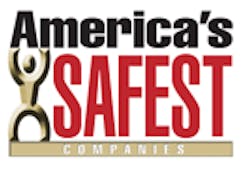The transition from small, family-owned carpentry subcontractor to multi-service, multi-region general contractor is not without its trials and tribulations. But the track record of Willoughby, Ohio-based Marous Brothers Construction Inc. suggests that the company is up to the challenge.
Marous Brothers averages 500-700 field employees on more than 40 ongoing project sites in four states - and currently is contracted for projects in an additional four states. More employees on more work sites translates into greater potential for injuries - whether from falls, trench work and excavations or power equipment. Even so, the company's lost-time injury rate is well below the industry average, and continues to decline.
But safety wasn't always a top priority, admits Scott Marous, who co-owns the company with brothers Chip and Ken. “We were kids in our twenties when we started the company. No one was really focusing on safety in the 80s and, like most ‘kids,’ we thought we were invincible.”
Times, however, have changed, and so has Marous Brothers. It was in 2000 that the company's “culture of safety” began to take hold. “We now realize that it takes only a split-second to change the life of an entire family. As an owner, it's my job to be proactive, ensuring that all our workers return home each night injury-free.”
DRILLING IT DOWN
Teaching by example is more than a slogan to Marous, who cites “drilling it down” as the most critical of the company's safety philosophies. To that end, company owners and management never set foot on any job site without donning their safety glasses and hard hats, and seize every opportunity to provide positive feedback. The “Caught-in-the-Act Award” has proven a simple but effective vehicle for doing so. The personalized documents are awarded to field employees “caught” following sound safety practices, and especially are prized when accompanied by an article of company apparel.
Marous Brothers prides itself on a commitment to surpassing industry requirements, including a 100 percent, 6-foot fall-protection requirement and a company-wide, drug-free workplace requirement (including subcontractors). In the quest for a zero-incident work environment, the safety committee (a general superintendent, superintendent, foreman, senior project manager and the safety director) meets at least quarterly, providing input on the best ways to enlist company-wide “buy-in” on proposed practice and policy changes.
CAN YOU HEAR ME NOW?
Best intentions notwithstanding, says Marous, “men aren't the best communicators.” For this reason, observation tools are coupled with creative strategies for getting the message to each and every worker.
-
Mandatory project-wide “tool-box safety meetings” are held each Monday to “shake out the weekend cobwebs” and reinforce safety practices.
-
The “Safety Snapshot” is a report of observations made during unannounced job-site visits by the safety director or general superintendent. Supervisors not meeting the company's compliance level are counseled by their general superintendents.
-
“The Chalkline,” a bi-monthly employee newsletter featuring a safety-related article, is distributed to all field and office employees.
-
An anonymous TQM and Safety Tip Line allows employees to communicate any concerns, with messages retrieved and forwarded (in writing) to the owners and safety director for review and appropriate action.
Near misses are communicated to other job sites by the safety director and general superintendents. And, in keeping with a commitment to the safety of all workers, subcontractors' team members attend weekly safety talks given by Marous supervisors.
WITH GROWTH COMES OPPORTUNITY
Marous views his company's “growing pains” as learning opportunities, citing a broadening of their approach to safety as a byproduct of the need to deal with the different priorities of different OSHA offices as the company expands geographically.
He notes that the comany recently decided to require OSHA's 30-hour training (versus 10-hour) for all field supervisors, as well as “refresher training” every 2 years or so. “Ten hours just isn't enough any more,” he maintains.
Effective safety/loss prevention is critical not only to employee safety, but also to continued long-term growth. “From owner to apprentice, we're proud of how far we've come since our “safety awakening,” and will continue to live and breathe our goal of achieving and maintaining a zero-incident safety culture.”
Return to America's Safest Companies
